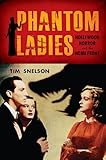Phantom Ladies : Hollywood Horror and the Home Front / Tim Snelson.
Material type: TextPublisher: New Brunswick, NJ : Rutgers University Press, [2014]Copyright date: ©2014Description: 1 online resource (224 p.) : 16 photographsContent type:
TextPublisher: New Brunswick, NJ : Rutgers University Press, [2014]Copyright date: ©2014Description: 1 online resource (224 p.) : 16 photographsContent type: - 9780813570433
- 9780813570440
- 791.43/61640820973 23
- PN1995.9.H6 S6185 2015
- PN1995.9.H6 S6185 2015eb
- online - DeGruyter
- Issued also in print.
| Item type | Current library | Call number | URL | Status | Notes | Barcode | |
|---|---|---|---|---|---|---|---|
 eBook
eBook
|
Biblioteca "Angelicum" Pont. Univ. S.Tommaso d'Aquino Nuvola online | online - DeGruyter (Browse shelf(Opens below)) | Online access | Not for loan (Accesso limitato) | Accesso per gli utenti autorizzati / Access for authorized users | (dgr)9780813570440 |
Frontmatter -- Contents -- Acknowledgments -- Introduction: Horror On The Home Front -- 1. Rebecca Meets The Wolfman At Rko: The Emergence Of The Female Monster Cycle, 1942-1943 -- 2. Series, Sequels, And Double Bills: The Evolution Of The Female Monster Cycle, 1943-1944 -- 3. A-Class Monsters: The Escalation Into Prestige Productions, 1944-1945 -- 4. From Whatdunit To Whodunit: The Postwar Psychologization Of Horror, 1945-1946 -- Conclusion: Only For The Duration -- Notes -- Index -- About The Author
restricted access online access with authorization star
http://purl.org/coar/access_right/c_16ec
Defying industry logic and gender expectations, women started flocking to see horror films in the early 1940s. The departure of the young male audience and the surprise success of the film Cat People convinced studios that there was an untapped female audience for horror movies, and they adjusted their production and marketing strategies accordingly. Phantom Ladies reveals the untold story of how the Hollywood horror film changed dramatically in the early 1940s, including both female heroines and female monsters while incorporating elements of "women's genres" like the gothic mystery. Drawing from a wealth of newly unearthed archival material, from production records to audience surveys, Tim Snelson challenges long-held assumptions about gender and horror film viewership. Examining a wide range of classic horror movies, Snelson offers us a new appreciation of how dynamic this genre could be, as it underwent seismic shifts in a matter of months. Phantom Ladies, therefore, not only includes horror films made in the early 1940s, but also those produced immediately after the war ended, films in which the female monster was replaced by neurotic, psychotic, or hysterical women who could be cured and domesticated. Phantom Ladies is a spine-tingling, eye-opening read about gender and horror, and the complex relationship between industry and audiences in the classical Hollywood era.
Issued also in print.
Mode of access: Internet via World Wide Web.
In English.
Description based on online resource; title from PDF title page (publisher's Web site, viewed 30. Aug 2021)


